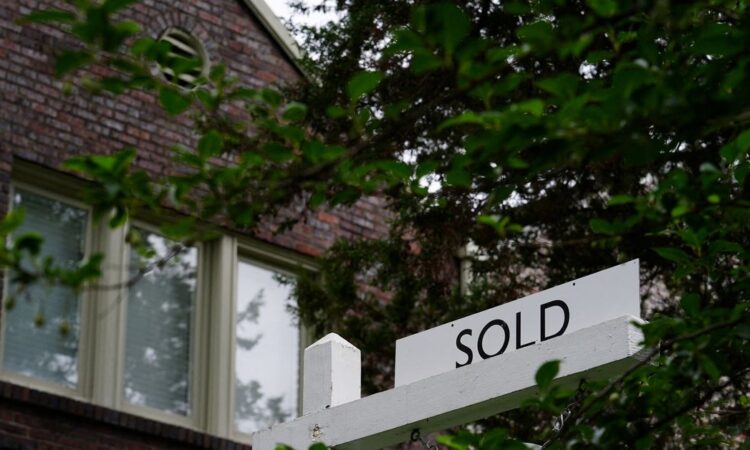
WASHINGTON, April 18 (Reuters) – U.S. single-family homebuilding increased for a second straight month in March, while permits for future construction surged, offering some glimmers of hope for the depressed housing market ahead of the busy spring selling season.
The improvement in the single-family housing market segment, which was reported by the Commerce Department on Tuesday, likely reflected buyers taking advantage of a retreat in mortgage rates. A survey on Monday showed falling mortgage rates and tight supply of previously owned houses were supporting the new home market.
“Mortgage rates have pulled back from the peaks in October/November, helping to provide a jolt to demand and sales activity,” said Ben Ayers, a senior economist at Nationwide in Columbus, Ohio. “But the environment remains challenging with high input and labor costs for builders and expensive financing options for buyers.”
Single-family housing starts, which account for the bulk of homebuilding, rose 2.7% to a seasonally adjusted annual rate of 861,000 units last month. Data for February was revised higher to show single-family homebuilding rising to a rate of 838,000 units instead of the previously reported pace of 830,000 units.
Single-family homebuilding increased 4.4% in the Northeast and soared 23.6% in the Midwest. It advanced 4.8% in the densely populated South, but plunged 16.0% in the West. Single-family housing starts dropped 27.7% on a year-on-year basis in March.
The Federal Reserve’s aggressive interest rate hikes have pushed the housing market into recession, with residential investment contracting for seven straight quarters, the longest such streak since the collapse of the housing bubble triggered by the 2007-2009 Great Recession.
There are, however, signs the housing market is stabilizing at very depressed levels. The National Association of Home Builders/Wells Fargo Housing Market index climbed to a seven-month high in April.
Mortgage rates have fallen from last year’s highs, with the average rate on the popular 30-year fixed mortgage declining from a peak of 7.08% in early November to 6.27% last week, according to data from mortgage finance agency Freddie Mac.
Those rates have decreased in tandem with U.S. Treasury yields on hopes that the Fed would not continue raising borrowing costs beyond next month amid signs that the economy was slowing.
But the recent financial turmoil following the collapse of two regional banks could result in banks and mortgage lenders tightening underwriting standards.
“Tighter credit conditions would result in homebuilders having a harder time financing new projects, which would weigh on future construction activity,” said Doug Duncan, chief economist at Fannie Mae.
Stocks on Wall Street were trading lower. The dollar fell against a basket of currencies. U.S. Treasury prices rose.
COMPLETIONS RISE
Starts for housing projects with five units or more decreased 6.7% to a rate of 542,000 units. Multi-family housing construction remains underpinned by demand for rental accommodation. But economists see limited scope for further gains, noting an increase in empty apartments. The inventory of multi-family housing under construction is at record highs.
“There is a hint here that the baton is maybe being passed from rental construction to construction for home purchase,” said Conrad DeQuadros, senior economic advisor at Brean Capital in New York. “None of this is to suggest a strong revival in housing activity, but it does support the view that the worst of the declines may be behind us for now.”
With the decline in multi-family homebuilding offsetting the rise in single-family projects, overall housing starts fell 0.8% to a rate of 1.420 million units last month.
Economists polled by Reuters had forecast starts would fall to a rate of 1.40 million in March.
Single-family building permits jumped 4.1% to a rate of 818,000 units in March, a five-month high. They rose in the Northeast, South and West, but were unchanged in the Midwest.
Permits for housing projects with five units or more plummeted 24.3% to a rate of 543,000 units. Overall, building permits dropped 8.8% to a rate of 1.413 million units.
The number of houses approved for construction that are yet to be started declined 3.0% to 291,000 units. The single-family homebuilding backlog fell 2.3% to 130,000 units, the lowest level since February 2021, while the completions rate for this segment rose 2.4% to a rate of 1.050 million units.
The inventory of single-family housing under construction fell 2.3% to a rate of 716,000 units, the lowest level since August 2021.
“The housing sector seems poised to have some new completed inventory in coming months,” said Colin Johanson, an economist at Barclays in New York.
Reporting by Lucia Mutikani; Editing by Chizu Nomiyama
Our Standards: The Thomson Reuters Trust Principles.




